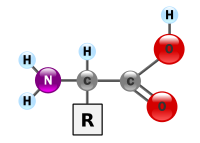
Photo from wikipedia
Assessment of protein structure and interaction is crucial for understanding protein structure/function relationships. Compared to high-resolution structural tools, including X-ray crystallography, nuclear magnetic resonance (NMR), and cryo-EM, and traditional low-resolution… Click to show full abstract
Assessment of protein structure and interaction is crucial for understanding protein structure/function relationships. Compared to high-resolution structural tools, including X-ray crystallography, nuclear magnetic resonance (NMR), and cryo-EM, and traditional low-resolution methods, such as circular dichroism, UV-vis, and florescence spectroscopy, mass spectrometry (MS)-based protein footprinting affords medium-to-high resolution (i.e., regional and residue-specific insights) by taking advantage of proteomics methods focused on the primary structure. The methodology relies on "painting" the reactive and solvent-exposed amino acid residues with chemical tags and using the pattern of modifications as footprints from analysis by bottom-up MS-based proteomics to deduce protein higher order structures. The outcome can refer to proteins in solution or even in cells and is complementary to those of X-ray crystallography and NMR. It is particularly useful in mapping protein-ligand interfaces and conformational changes resulting from ligand binding, mutation, and aggregation. Fast photochemical oxidation of proteins (FPOP), in its original conception, is a type of hydroxyl-radical-based protein footprinting that utilizes a pulsed KrF laser (248 nm) to trigger hydrolysis of hydrogen peroxide to produce solution hydroxyl radicals, which subsequently modify the protein in situ. The platform is expanding to adopt other reactive species including carbenes. The reactivity of the probe depends on the intrinsic reactivity of the radical with the residue side chain and the solvent accessibility of the residue as a function of the tertiary/quaternary structures. By introducing an appropriate scavenger to compete with hydroxyl radical self-quenching, the lifetime of the primary radicals is remarkably shortened to approximately microsecond. Thus, the sampling time scale of FPOP is much faster than hydrogen-deuterium exchange and other covalent labeling methods relying on nonradical reactions. The short footprinting time scale of FPOP offers two major advantages for protein structure elucidation: (1) it allows the protein to be interrogated in its native or near-native state with minimum structural perturbation; (2) it exhibits high sensitivity toward alterations in protein higher order structures because its sampling time is short with respect to protein conformational changes and dynamic motion. In addition, the covalent and irreversible oxidation by the hydroxyl radical provides more flexibility in the downstream proteomics workflow and MS analysis, permitting high spatial resolution with residue-specific information. Since its invention in 2005 by Hambly and Gross, FPOP has developed from proof-of-concept to a valuable biophysical tool for interrogating protein structure. In this Account, we summarize the principles and experimental design of FPOP that enable its fast labeling and describe the current and unique capabilities of the technique in protein higher order structure elucidation. Application examples include characterization of amyloid β self-assembly, protein-ligand interactions with a special emphasis on epitope mapping for protein therapeutics (e.g., antibody, Fab, and adnectin), protein folding detailed to residue-specific folding kinetics, and protein flexibility/dynamics. Additionally, the utility of FPOP-based oxidative footprinting should grow with our continuing developments of novel reagents (e.g., sulfate radical anion, carbene diradical, and trifluoromethyl radical). These reactive reagents are compatible with the current FPOP platform and offer different reactivity and selectivity toward various types of amino acid residues, providing complementary insights into protein higher order structures for soluble proteins and ultimately for membrane-bound proteins.
Journal Title: Accounts of chemical research
Year Published: 2018
Link to full text (if available)
Share on Social Media: Sign Up to like & get
recommendations!